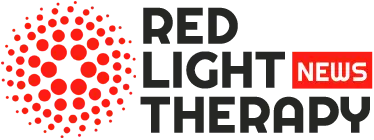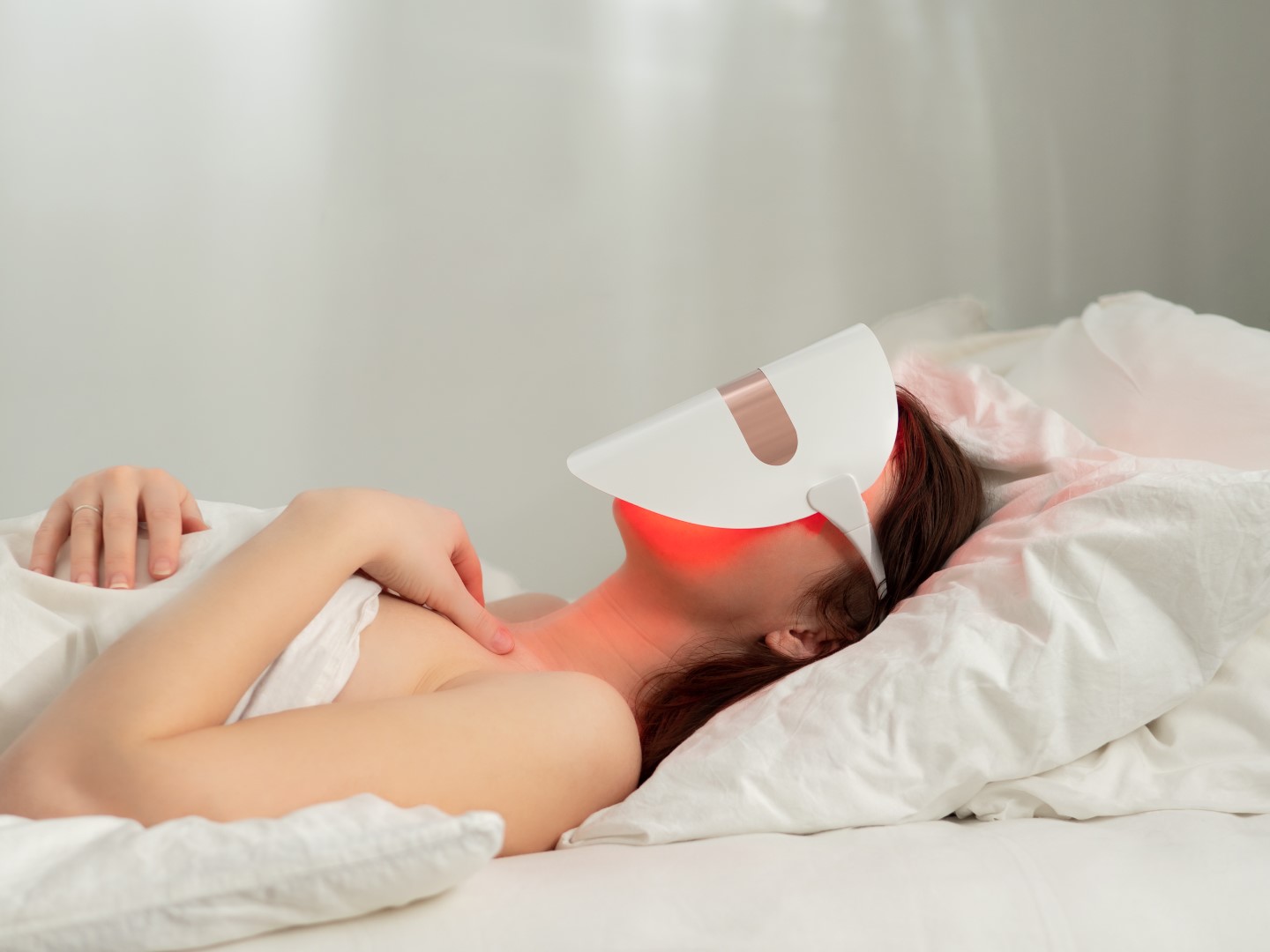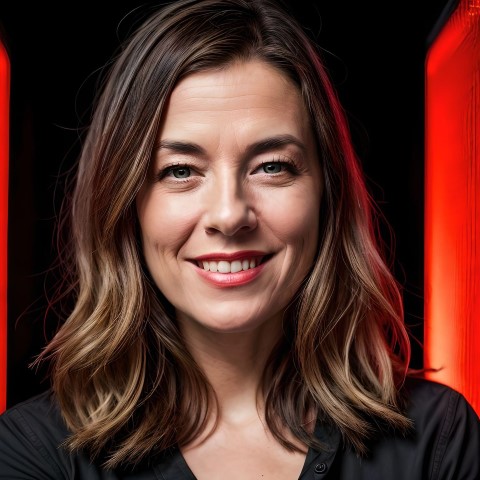Beyond Anti-Aging: RLT's Comprehensive Solution for Diverse Skin Concerns
In recent years, Red Light Therapy (RLT) has become increasingly popular as a safe, painless, and accessible treatment option for a range of skin conditions. This therapy harnesses the power of low-level wavelengths of red light to penetrate the skin's layers and promote healing and regeneration.
Numerous studies have investigated the potential benefits of RLT in promoting skin health. Some of the most compelling findings suggest that RLT can reduce the appearance of fine lines and wrinkles, improve skin texture and tone, and treat various skin conditions such as acne and psoriasis. Furthermore, RLT is increasingly being used as a way to rejuvenate and maintain skin health and appearance.
The use of RLT for skin health has been a fast-progressing area of research, and its non-invasive nature makes it an attractive option for an ever-increasing number of consumers seeking natural, safe and effective alternatives to traditional skin treatments.
While red light therapy (RLT) has shown promise in treating various skin conditions, the effectiveness of RLT can vary depending on the individual and the specific condition being treated.
Some of the skin concerns that RLT has been shown to be beneficial for include:
| Acne |
| Psoriasis |
| Eczema |
| Rosacea |
| Vitiligo |
| Fine lines and wrinkles |
| Uneven skin tone and Hyperpigmentation |
| Scarring |
| Stretch marks |
| Sun damage |
| Wound healing |
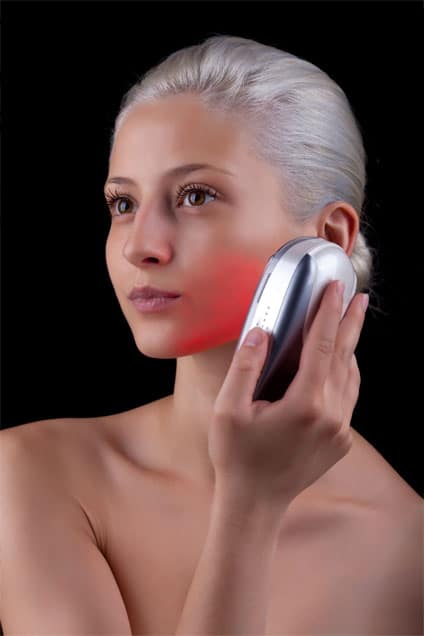
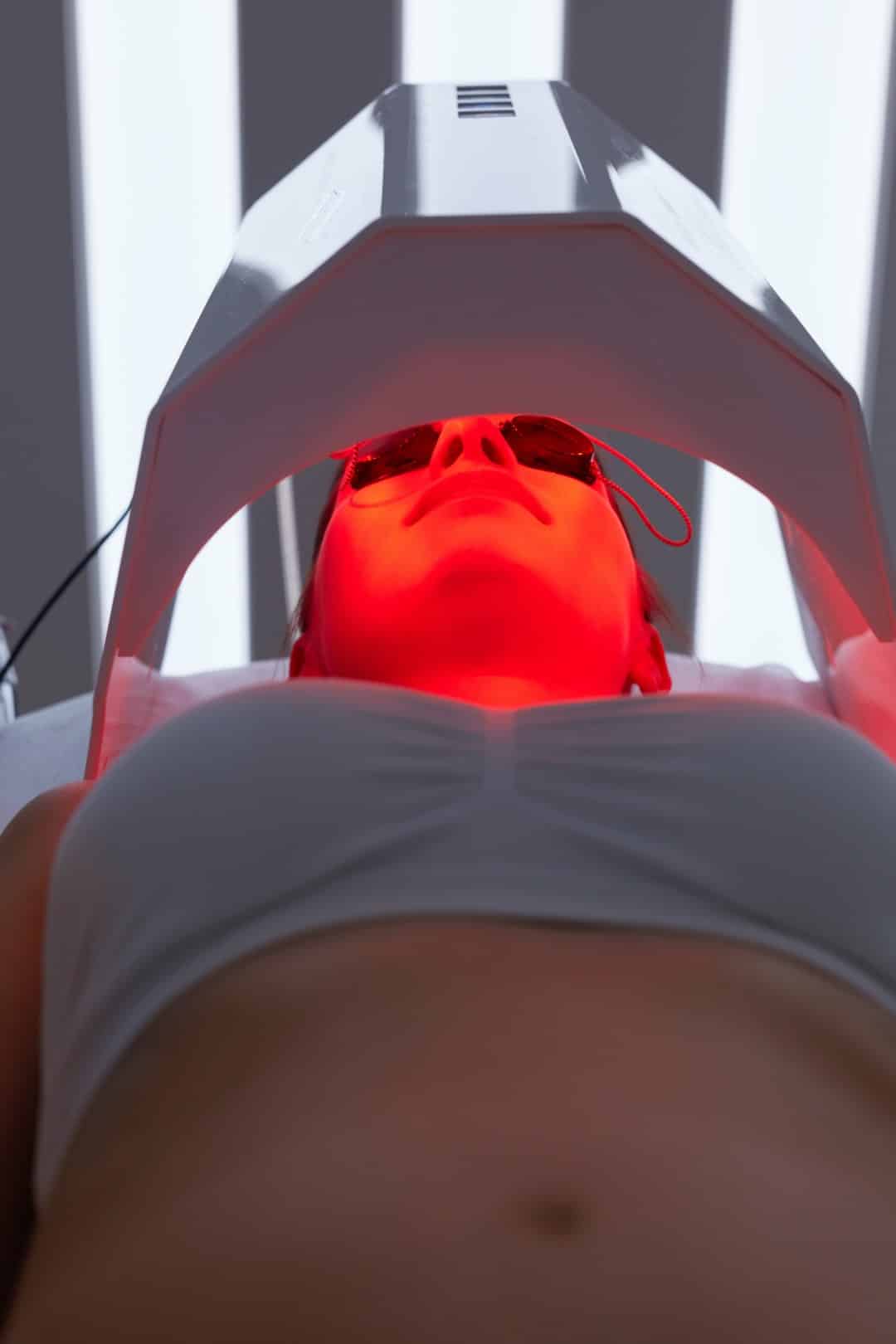
How does Red Light Therapy work for the skin?
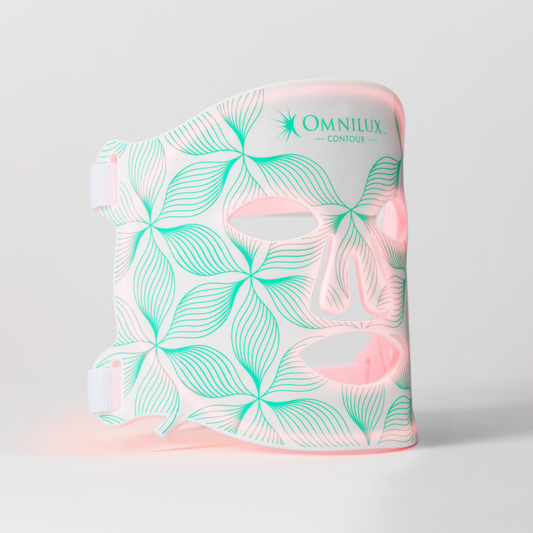
Red Light Therapy (RLT), also known as Low-Level Light Therapy (LLLT), delivers low levels of red or near-infrared light to the skin.
This light penetrates the skin's surface without causing any damage or producing UV radiation.
This light is absorbed by the mitochondria, the energy-producing organelles in the cells, which stimulates the production of adenosine triphosphate (ATP), the energy currency of the cell.
This increase in ATP production triggers a cascade of cellular processes that can have numerous remarkable benefits for the skin.
Discover our recommended Best Red Light Therapy Devices for Skin Care and Skin Rejuvenation
Some of the benefits of RLT for skin care include:
Improved collagen production:
RLT can stimulate fibroblasts, which are the cells responsible for producing collagen, the protein that gives the skin its elasticity and firmness. Increased collagen production can help to reduce the appearance of fine lines and wrinkles, improve skin texture, and promote skin elasticity.
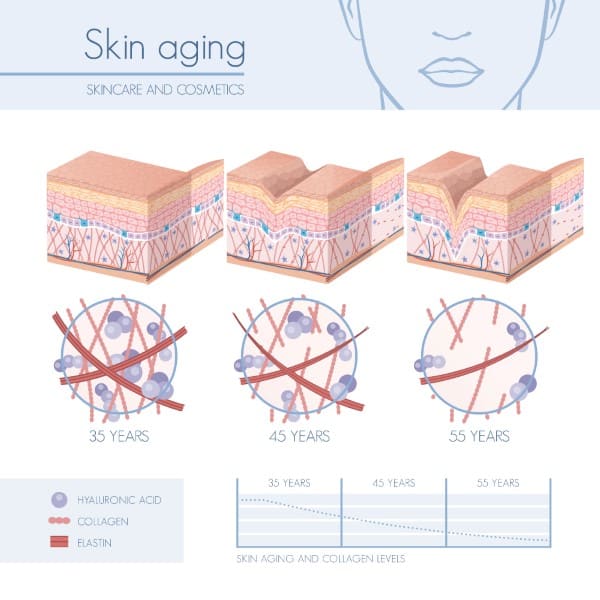
One of the primary mechanisms of action of RLT is its ability to increase the production of collagen, a protein that is important for maintaining the strength and elasticity of the skin. Collagen is produced by specialized cells in the skin known as fibroblasts.
These cells play a key role in maintaining the structure and function of the skin, and they are responsible for producing and remodeling the extracellular matrix, which provides support and nourishment to the skin cells.
When exposed to red or near-infrared light, fibroblasts are believed to undergo a process known as photobiomodulation, which can stimulate the production of collagen and other extracellular matrix components.
This, in turn, can lead to improvements in skin texture, firmness, and elasticity, as well as a reduction in the appearance of fine lines, wrinkles, and other signs of aging.
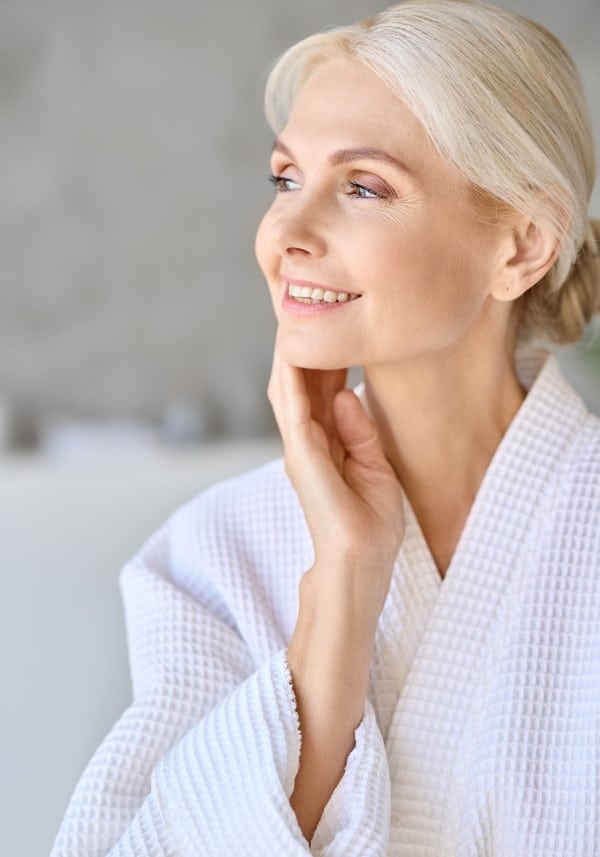
Reduced inflammation:
RLT has been shown to have anti-inflammatory effects, reducing the appearance of redness, swelling, and inflammation associated with various skin conditions, such as acne, rosacea, psoriasis and other inflammatory skin disorders. This non-invasive treatment enhances skin health by targeting inflammation at the cellular level.
Increased circulation:
RLT has also been shown to increase blood flow and circulation in the skin. Improved circulation delivers a greater supply of oxygen and nutrients to the skin cells while simultaneously facilitating more efficient removal of waste products.
This enhanced blood flow not only contributes to a revitalized and radiant complexion but also supports the skin’s inherent healing processes, fostering a healthier, more vibrant appearance.
Improved wound healing and repair:
Red Light Therapy (RLT) offers a remarkable capability to stimulate the production of new skin cells, thereby playing a pivotal role in the expedited healing of wounds, scars, and other skin damage. The enhanced cellular metabolism increase the production of collagen and elastin, two key proteins that facilitate skin regeneration and repair.
Reduced appearance of age spots and hyperpigmentation:
Particularly, when it comes to age spots and hyperpigmentation, RLT helps by modulating the production of melanin, the pigment responsible for skin color, and promoting the growth of new skin cells to replace discolored areas.
Moreover, the enhanced cellular activity and increased blood flow to the treated area facilitate a natural healing environment, wherein the skin gradually manifests a more uniform tone and reduced visibility of spots and pigmented regions. Therefore, RLT provides a non-invasive approach to manage and potentially diminish the signs of age spots and hyperpigmentation, contributing to a more even and youthful skin appearance.
These benefits can help to promote overall skin health and improve the appearance of the skin.
Is Red Light Therapy effective for my skin condition?
Red Light Therapy (RLT) has been studied extensively in recent years, and the available scientific data indicate that it is a safe and effective treatment option for a variety of skin conditions. Below we explore the most common ones:
Red Light Therapy (RLT) for Acne
RLT can be effective in treating mild to moderate acne. The therapy has been shown to have anti-inflammatory effects and can reduce the appearance of redness, swelling, and inflammation associated with acne. It can reduce the production of sebum and help to minimize scarring from acne.
One study published in the Journal of Cosmetic and Laser Therapy in 2017 found that RLT was effective in reducing the number of acne lesions in participants. The study involved 30 participants with mild to moderate acne, who received eight sessions of RLT over a four-week period. The results showed a significant reduction in the number of inflammatory acne lesions, as well as a decrease in sebum production and an improvement in skin texture.
Another study published in the Journal of Dermatological Treatment in 2016 found that RLT was effective in reducing the severity of acne in participants. The study involved 52 participants with moderate to severe acne, who received 12 sessions of RLT over a six-week period. The results showed a significant reduction in acne severity, as well as a decrease in sebum production and an improvement in skin texture.
A third study published in the Journal of Clinical and Aesthetic Dermatology in 2018 found that RLT was effective in reducing the size and number of acne lesions in participants. The study involved 36 participants with mild to moderate acne, who received six sessions of RLT over a three-week period. The results showed a significant reduction in the size and number of acne lesions, as well as an improvement in skin texture.

Red Light Therapy (RLT) for Psoriasis
Psoriasis is a chronic autoimmune skin condition that causes inflammation, redness and scaling of the skin. It affects millions of people worldwide, and while there is no known cure for psoriasis, RLT has been found to be beneficial in managing symptoms. RLT can reduce inflammation and redness of the skin, improve overall skin texture, and promote healing.
RLT (Red Light Therapy) is a type of phototherapy that has been shown to be effective in treating psoriasis, a chronic autoimmune skin condition that causes inflammation and the development of scaly, red patches on the skin. Several studies have demonstrated the benefits of RLT for psoriasis.
One study published in the Journal of Dermatological Treatment in 2014 found that RLT was effective in reducing the severity of psoriasis in participants. The study involved 30 participants with mild to moderate psoriasis, who received 20 sessions of RLT over a 10-week period. The results showed a significant reduction in the severity of psoriasis, as well as an improvement in quality of life for the participants.
Another study published in the Journal of Photochemistry and Photobiology in 2015 found that RLT was effective in reducing inflammation and promoting healing in psoriasis lesions. The study involved 14 participants with moderate to severe psoriasis, who received eight sessions of RLT over a four-week period. The results showed a significant reduction in inflammation and redness, as well as an improvement in skin texture and healing of psoriasis lesions.
A third study published in the Journal of the European Academy of Dermatology and Venereology in 2018 found that RLT was effective in reducing the severity of psoriasis in participants with psoriatic arthritis. The study involved 60 participants with psoriasis and psoriatic arthritis, who received 20 sessions of RLT over a 10-week period. The results showed a significant reduction in the severity of psoriasis, as well as an improvement in joint pain and function for the participants.

Red Light Therapy (RLT) for Eczema
RLT has been found to be beneficial in the treatment of eczema, a chronic skin condition characterized by red, itchy, and inflamed skin. Several studies have been conducted in recent years that have demonstrated the effectiveness of RLT treatment in reducing symptoms.
One study published in the Journal of Investigative Dermatology in 2013 found that RLT was effective in reducing inflammation and improving skin barrier function in individuals with eczema. The study involved 30 participants with mild to moderate eczema, who received 14 sessions of RLT over a four-week period. The results showed a significant reduction in inflammation and an improvement in skin barrier function, leading to a reduction in eczema symptoms.
Another study published in the Journal of Dermatological Treatment in 2017 found that RLT was effective in reducing the severity of eczema symptoms in participants. The study involved 36 participants with mild to moderate eczema, who received eight sessions of RLT over a four-week period. The results showed a significant reduction in eczema symptoms, including redness, itching, and scaling.
A third study published in the British Journal of Dermatology in 2017 found that RLT was effective in reducing the severity of eczema symptoms and improving quality of life in individuals with moderate to severe eczema. The study involved 62 participants who received either RLT or a placebo treatment over a 12-week period. The results showed a significant reduction in eczema symptoms and an improvement in quality of life for participants who received RLT.

Red Light Therapy (RLT) for Rosacea
Rosacea is a chronic skin condition that causes redness, flushing, and inflammation of the face, often accompanied by visible blood vessels and acne-like bumps. RLT has been found to be beneficial in managing and considerably reducing the symptoms.
RLT (Red Light Therapy) is a type of phototherapy that has been found to be beneficial in the treatment of rosacea, a chronic inflammatory skin condition that causes redness and visible blood vessels on the face. Several studies have been conducted in recent years that have demonstrated the effectiveness of RLT in the treatment of rosacea.
One study published in the Journal of Cosmetic and Laser Therapy in 2017 found that RLT was effective in reducing the severity of rosacea symptoms in participants. The study involved 36 participants with moderate to severe rosacea, who received 10 sessions of RLT over a five-week period. The results showed a significant improvement in rosacea symptoms, including redness, flushing, and visible blood vessels on the face.
Another study published in the Journal of Photochemistry and Photobiology in 2018 found that RLT was effective in reducing inflammation and improving skin barrier function in individuals with rosacea. The study involved 20 participants with mild to moderate rosacea, who received 12 sessions of RLT over a six-week period. The results showed a significant reduction in inflammation and an improvement in skin barrier function, leading to a reduction in rosacea symptoms.
A third study published in the Journal of the European Academy of Dermatology and Venereology in 2020 found that RLT was effective in reducing the severity of rosacea symptoms in participants with subtype 1 rosacea, which is characterized by persistent redness and flushing of the face. The study involved 45 participants with subtype 1 rosacea, who received eight sessions of RLT over a four-week period. The results showed a significant reduction in redness and flushing of the face, as well as an improvement in skin texture and quality.

Red Light Therapy (RLT) for Vitiligo
RLT has shown promise in managing the symptoms of vitiligo, a skin condition that causes the loss of skin pigment, resulting in white patches on the skin. RLT has been found to promote repigmentation of the skin by stimulating melanocytes, the cells responsible for producing skin pigment. This can help to even out skin tone and reduce the appearance of white patches.
RLT (Red Light Therapy) is a type of light therapy that has been found to be beneficial in the treatment of vitiligo, a skin condition characterized by loss of pigmentation in the skin, leading to white patches. Although vitiligo has no known cure, several studies have been conducted in recent years that have demonstrated the effectiveness of RLT in reducing the extent and severity of the condition.
One study published in the Journal of the American Academy of Dermatology in 2017 found that RLT was effective in reducing the size and severity of vitiligo lesions in participants. The study involved 15 participants with stable vitiligo, who received two sessions of RLT per week for a total of 24 weeks. The results showed a significant reduction in the size and severity of vitiligo lesions in all participants, with some individuals experiencing complete repigmentation of affected areas.
Another study published in the Journal of Cosmetic and Laser Therapy in 2018 found that RLT was effective in improving skin pigmentation and reducing the size of vitiligo lesions in participants. The study involved 16 participants with vitiligo, who received 24 sessions of RLT over a 12-week period. The results showed a significant improvement in skin pigmentation and a reduction in the size of vitiligo lesions in all participants.
A third study published in the Journal of Photochemistry and Photobiology in 2019 found that RLT was effective in increasing the activity of melanocytes, the cells responsible for producing pigment in the skin, in individuals with vitiligo. The study involved 24 participants with vitiligo, who received 16 sessions of RLT over an eight-week period. The results showed a significant increase in melanocyte activity and an improvement in skin pigmentation in all participants.

Red Light Therapy (RLT) for Fine lines and wrinkles
RLT has been shown to increase collagen production, which can improve the appearance of wrinkles and fine lines. It can also improve skin texture and tone.
RLT (Red Light Therapy) is a non-invasive skin treatment that has been found to be beneficial in reducing the appearance of fine lines and wrinkles. Several studies have been conducted in recent years that have demonstrated the effectiveness of RLT in improving skin texture, tone, and overall appearance.
One study published in the Journal of Cosmetic Dermatology in 2014 found that RLT was effective in improving skin elasticity and reducing the appearance of fine lines and wrinkles in participants. The study involved 30 participants who received eight sessions of RLT over a four-week period. The results showed a significant improvement in skin elasticity, as well as a reduction in the number and depth of fine lines and wrinkles.
Another study published in the Journal of Clinical and Aesthetic Dermatology in 2018 found that RLT was effective in reducing the appearance of periorbital wrinkles, or wrinkles around the eyes, in participants. The study involved 52 participants who received 12 sessions of RLT over a four-week period. The results showed a significant reduction in the depth and severity of periorbital wrinkles in all participants.
A third study published in the Journal of Cosmetic and Laser Therapy in 2019 found that RLT was effective in improving skin texture and reducing the appearance of fine lines and wrinkles in participants. The study involved 30 participants who received 12 sessions of RLT over a six-week period. The results showed a significant improvement in skin texture, as well as a reduction in the number and depth of fine lines and wrinkles.

Red Light Therapy (RLT) for Uneven skin tone and hyperpigmentation
Uneven skin tone and hyperpigmentation are common skin concerns that can be caused by a variety of factors, such as sun damage, hormonal changes, and acne scars. RLT has been found to be beneficial in reducing the appearance of hyperpigmentation by promoting cell turnover and improving skin texture.
RLT (Red Light Therapy) is a type of light therapy that has been found to be beneficial in improving the appearance of uneven skin tone. Several studies have been conducted in recent years that have demonstrated the effectiveness of RLT in reducing the appearance of hyperpigmentation, dark spots, and other forms of uneven skin tone.
One study published in the Journal of Cosmetic Dermatology in 2017 found that RLT was effective in reducing the appearance of hyperpigmentation and improving overall skin tone in participants. The study involved 28 participants with mild to moderate hyperpigmentation, who received six sessions of RLT over a two-week period. The results showed a significant improvement in overall skin tone, as well as a reduction in the appearance of hyperpigmentation in all participants.
Another study published in the Journal of Investigative Dermatology in 2018 found that RLT was effective in reducing the appearance of dark spots and improving skin texture in participants. The study involved 30 participants with mild to moderate photodamage, who received 12 sessions of RLT over a six-week period. The results showed a significant improvement in skin texture, as well as a reduction in the number and size of dark spots in all participants.
A third study published in the Journal of Cosmetic Dermatology in 2019 found that RLT was effective in improving overall skin tone and reducing the appearance of melasma, a common form of hyperpigmentation, in participants. The study involved 20 participants with melasma, who received 10 sessions of RLT over a five-week period. The results showed a significant improvement in overall skin tone, as well as a reduction in the size and severity of melasma in all participants

Red Light Therapy (RLT) for Scarring
RLT has been shown to help reduce the appearance of scars by promoting collagen production and improving skin texture. This treatment can be used for various types of scars, including acne scars, surgical scars, and scars from injuries.
RLT (Red Light Therapy) is a non-invasive skin treatment that has been found to be beneficial in reducing the appearance of scars. Several studies have been conducted in recent years that have demonstrated the effectiveness of RLT in improving the appearance of both old and new scars.
One study published in the Journal of Cosmetic and Laser Therapy in 2014 found that RLT was effective in reducing the appearance of scars in participants. The study involved 36 participants with scars of various types, including surgical scars and acne scars, who received 10 sessions of RLT over a five-week period. The results showed a significant improvement in scar texture and appearance in all participants.
Another study published in the Journal of Investigative Dermatology in 2017 found that RLT was effective in improving the appearance of hypertrophic scars, a type of raised scar that can occur after surgery or injury. The study involved 12 participants with hypertrophic scars, who received three sessions of RLT per week over a four-week period. The results showed a significant reduction in scar thickness and redness in all participants.
A third study published in the Journal of Clinical and Aesthetic Dermatology in 2018 found that RLT was effective in improving the appearance of both old and new scars in participants. The study involved 21 participants with scars of various types and ages, who received 24 sessions of RLT over a 12-week period. The results showed a significant improvement in scar texture and appearance, as well as a reduction in scar redness and thickness, in all participants.

Red Light Therapy (RLT) for Stretch marks
RLT has been found to be helpful in reducing the appearance of stretch marks by improving skin elasticity and promoting collagen production. This treatment can be used for both new and old stretch marks, and may also help to prevent new stretch marks from forming.
RLT (Red Light Therapy) is a non-invasive treatment that has been found to be beneficial in reducing the appearance of stretch marks. Several studies have been conducted in recent years that have demonstrated the effectiveness of RLT in improving the texture and appearance of stretch marks.
One study published in the Journal of Cosmetic and Laser Therapy in 2014 found that RLT was effective in reducing the appearance of stretch marks in participants. The study involved 37 participants with stretch marks, who received 20 sessions of RLT over a 10-week period. The results showed a significant improvement in stretch mark texture and appearance in all participants.
Another study published in the Journal of Cosmetic Dermatology in 2018 found that RLT was effective in improving the appearance of both red and white stretch marks in participants. The study involved 22 participants with stretch marks, who received six sessions of RLT over a two-week period. The results showed a significant reduction in the size and color of both red and white stretch marks in all participants.
A third study published in the Journal of Photochemistry and Photobiology in 2018 found that RLT was effective in improving the appearance of post-pregnancy stretch marks in participants. The study involved 24 participants with post-pregnancy stretch marks, who received 24 sessions of RLT over a 12-week period. The results showed a significant improvement in stretch mark texture and appearance, as well as a reduction in skin laxity and overall skin quality, in all participants.

Red Light Therapy (RLT) for Sun damage
RLT can be an effective treatment for sun damage by reducing inflammation, improving skin texture, and promoting collagen production. This treatment can help to reduce the appearance of fine lines, wrinkles, and hyperpigmentation caused by sun exposure.
RLT (Red Light Therapy) is a non-invasive treatment that has been found to be beneficial in reducing the signs of sun damage on the skin. Sun damage can cause various skin issues such as sunspots, fine lines, and wrinkles. Several studies have been conducted in recent years that have demonstrated the effectiveness of RLT in improving the texture and appearance of sun-damaged skin.
One study published in the Journal of Investigative Dermatology in 2013 found that RLT was effective in improving the appearance of sun-damaged skin in participants. The study involved 52 participants with mild to moderate sun damage, who received eight sessions of RLT over a four-week period. The results showed a significant improvement in skin texture, tone, and hydration in all participants.
Another study published in the Journal of Cosmetic Dermatology in 2017 found that RLT was effective in reducing the appearance of sunspots in participants. The study involved 25 participants with sunspots, who received 12 sessions of RLT over a six-week period. The results showed a significant reduction in the size and color of sunspots in all participants.
A third study published in the Journal of Clinical and Aesthetic Dermatology in 2018 found that RLT was effective in improving the appearance of fine lines and wrinkles caused by sun damage in participants.
The study involved 30 participants with sun-damaged skin, who received 24 sessions of RLT over a 12-week period. The results showed a significant improvement in skin texture, tone, and elasticity, as well as a reduction in the appearance of fine lines and wrinkles in all participants.

Red Light Therapy (RLT) for Wound healing
RLT has been found to be beneficial in promoting wound healing in various types of wounds. Several studies have been conducted in recent years that have demonstrated the effectiveness of RLT in improving wound healing rates and reducing scar formation.
One study published in the journal Lasers in Medical Science in 2018 found that RLT was effective in improving wound healing rates in patients with chronic diabetic foot ulcers. The study involved 30 patients who received either RLT or a placebo treatment. The results showed that patients who received RLT had a significantly faster rate of wound healing and a lower incidence of infection compared to the placebo group.
Another study published in the Journal of Cosmetic and Laser Therapy in 2019 found that RLT was effective in reducing scar formation in patients who had undergone surgery. The study involved 20 patients who received RLT treatment for six weeks following surgery. The results showed a significant improvement in scar appearance and texture in all patients.
A third study published in the journal Photomedicine and Laser Surgery in 2020 found that RLT was effective in reducing inflammation and promoting tissue regeneration in patients with burn wounds. The study involved 20 patients who received RLT treatment for four weeks. The results showed a significant reduction in inflammation and a faster rate of wound healing in all patients.

What is the Effective Red Light Therapy Wavelength for Skin Care and Anti Aging?
Within the sphere of skincare, recent scientific studies have shed light on the distinct effectiveness of certain wavelengths for different skin conditions: for example, a wavelength optimal for acne may not be as beneficial to treat wrinkles or hyperpigmentation. In this discussion, we'll examine the benefits of variors wavelegth for more targeted treatments.
Generally speaking, the optimal wavelengths for Red Light Therapy (RLT) for skin-related concerns are typically in the range of 630-700 nanometers (nm) for red light and 700-850 nm for near-infrared light.
Red light in this range can penetrate the skin to a depth of several millimeters, stimulating cellular processes such as collagen production and reducing inflammation, which can lead to various benefits for the skin such as improved texture, reduced fine lines and wrinkles, and increased skin firmness.
Near-infrared light in this range can also penetrate the skin, providing additional benefits such as improved circulation and enhanced tissue repair. However, the specific wavelengths and duration of RLT required for optimal results may vary depending on the individual, the specific skin concern being addressed and the specification of the device used.
Red Light Therapy: Honing in on Wavelengths for Specific Skin Needs:
Skin rejuvenation and anti-aging RLT:
The optimal wavelengths for improving skin texture, reducing fine lines and wrinkles, and increasing skin firmness are typically in the range of 630-700 nanometers (nm) for red light and 700-850 nm for near-infrared light.
Psoriasis and eczema:
Red light therapy with a wavelength of around 630 nm has been found beneficial to reduce the inflammation associated with psoriasis and eczema.
Stretch marks:
A combination of red and near-infrared light therapy with wavelengths in the range of 630-850 nm has been found beneficial in improving the appearance of stretch marks.
Wound healing and scar reduction:
Near-infrared light therapy with a wavelength of around 800-850 nm has been found to help accelerate wound healing and reduce the appearance of scars.
Let's explore Other Light Therapy Wavelengths for targeted Skin Conditions:
Apart from Red Light Therapy (RLT), there are other forms of Light Therapy that are frequently utilized in skincare equipment individually or in combination with red light, including blue, orange, pink, yellow and green light. Various LED skincare devices combine multiple wavelengths of light (corresponding to different colours) in one device to address a broad range of skin care concerns. This approach ensures comprehensive coverage of the most typical skincare problems.
Each of these colours of light has its unique benefits for the skin, which we will discuss in more detail below:
Blue Light Therapy:
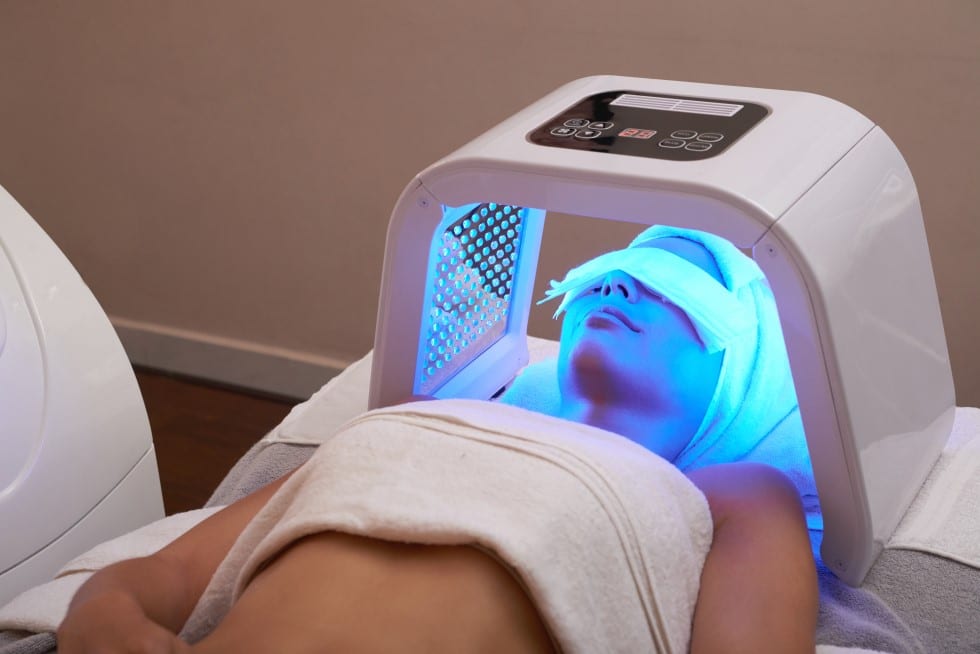
Blue light therapy works by using a specific wavelength of light (around 415 nm) that penetrates the skin's surface and targets the bacteria that cause acne. The light interacts with porphyrins, which are naturally occurring molecules in the skin that are produced by the bacteria that cause acne.
When these molecules are exposed to blue light, they generate reactive oxygen species (ROS), which are toxic to the bacteria, effectively killing them. Blue light therapy can also help to reduce inflammation and regulate sebum production, which can contribute to the formation of acne.
Orange Light Therapy:
Orange light therapy works by using a wavelength of light (around 620-630 nm) that stimulates the production of collagen in the skin. Collagen is a protein that gives skin its strength and elasticity, and as we age, our bodies produce less of it, leading to the development of fine lines and wrinkles.
When orange light is applied to the skin, it stimulates fibroblast cells in the skin to produce more collagen, which can help to reduce the appearance of fine lines and wrinkles and improve skin texture. Orange light therapy can also help to reduce inflammation and promote healing in damaged skin.
Pink Light Therapy:
Pink light therapy combines the benefits of red and blue light therapy. The red light (around 620-750 nm) stimulates cellular processes in the skin, promoting the production of collagen and improving circulation. This can help to reduce the appearance of fine lines and wrinkles, improve skin texture, and promote healing in damaged skin. The blue light (around 415 nm) targets the bacteria that cause acne, reducing inflammation and regulating sebum production.
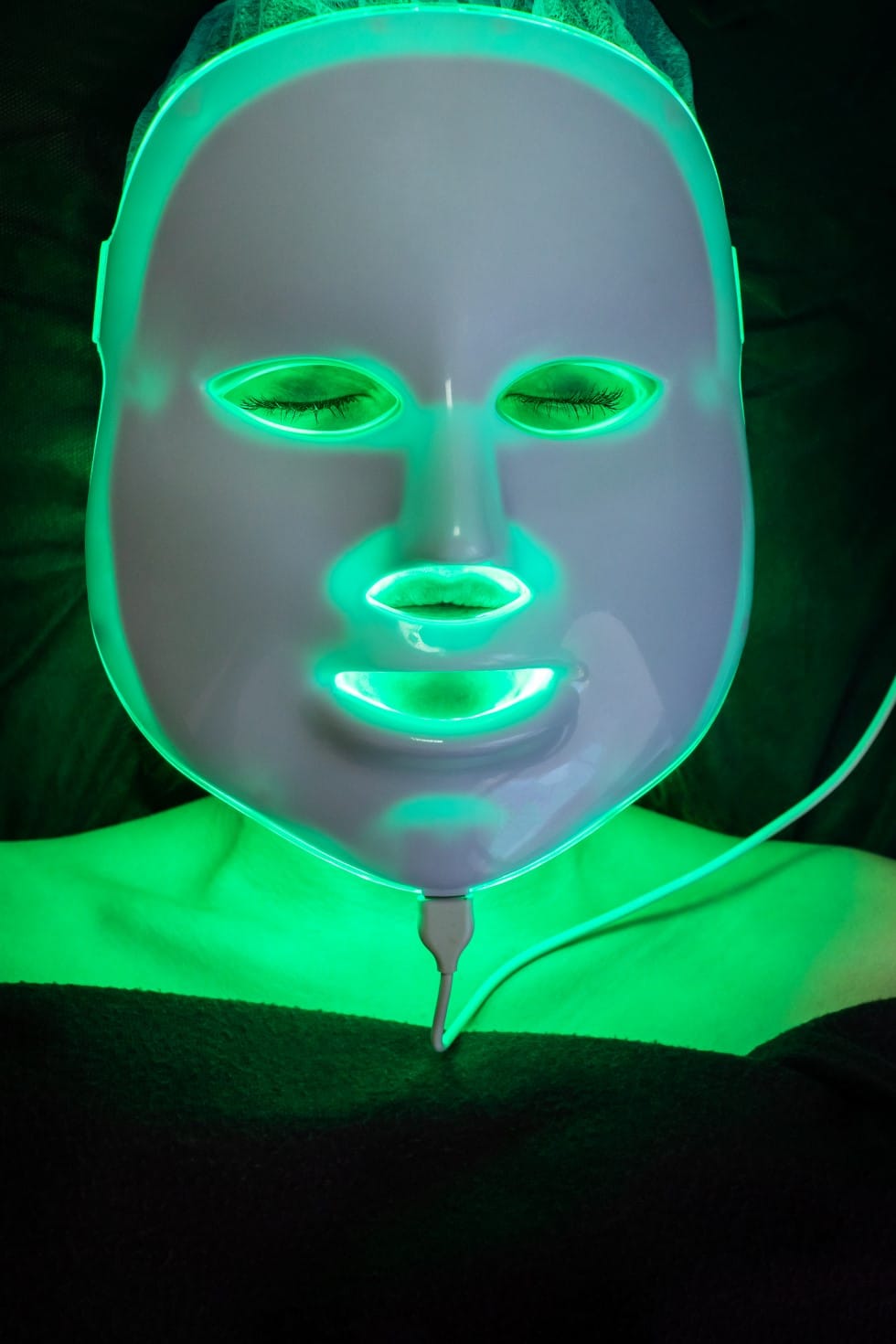
Green light therapy:
With a wavelength of around 525 nm is believed to help reduce hyperpigmentation and age spots.
Yellow light therapy:
With a wavelength of around 590 nm may be helpful in reducing redness and inflammation associated with rosacea and other skin conditions although the research available into the benefits of this Light Therapy is limited.
Again, it is important to note that the optimal wavelengths and duration of RLT or LLLT required for specific skin concerns may vary depending on the individual and the severity of the condition. Consulting with a healthcare professional or licensed esthetician can help determine the best course of treatment.
Final Thoughts And Safety
Red Light Therapy (RLT) can be an effective and non-invasive treatment option for improving skin texture, reducing the appearance of fine lines and wrinkles, and promoting overall skin health. It is safe, easy to use, and can be easily incorporated into your daily skincare routine.
Various highly effective medical-grade RLT devices for skin are now widely available for home use including professional-size RLT panels and beds. We suggest that you read our short Guidance on How to Select the Best Red Light Therapy Device for your specific condition and needs to ensure safety and efficacy.
Red light therapy is considered safe and most people will find the treatment relaxing but it's not recommended for individuals with light sensitive conditions, those who have had recent laser surgery or a chemical peel, those taking photosensitizing medications, pregnant or breastfeeding women, or people with a history of skin cancer.
As with any medical treatment, it is important to consult with a healthcare professional or dermatologist before starting any new skincare regimen, especially if you have any pre-existing medical conditions or concerns.
Questions We Are Often Asked:
Does Red light therapy (RLT) tan your skin?
RLT does not tan your skin. RLT uses low levels of red or near-infrared light to penetrate the skin without causing any damage or producing UV radiation.
It does not stimulate melanin production, which is responsible for tanning.
Can Red light therapy (RLT) lighten your skin?
Red light penetrates the skin deeper than normal light and stimulates the mitochondria; rejuvenating the skin, but it can’t change skin colour.
Can Red light therapy (RLT) cause skin cancer?
There is currently no evidence to suggest that red light therapy causes skin cancer. Red light therapy uses low levels of light and does not emit UV radiation, which is the primary cause of skin cancer.
Is Red light therapy (RLT) effective for skin rejuvenation?
Yes, RLT is an effective treatment option for skin rejuvenation. This therapy can help to reduce the signs of ageing, improve skin texture and tone, and promote overall skin health.
Does Red light therapy (RLT) cause dry skin?
Red light therapy does not cause dry skin. In fact, it can have the opposite effect and help to improve skin hydration and moisture retention.
Can Red light therapy (RLT) burn your skin?
Red light therapy is generally considered safe and does not burn the skin when used as directed.
Does Red light therapy (RLT) work on age spots?
Red light therapy can be effective in reducing the appearance of age spots. The therapy promotes collagen production and can improve skin texture and tone, which can help to fade the appearance of age spots over time.
How to prepare skin for Red light therapy (RLT)?
To prepare the skin for red light therapy, it is important to start with clean, dry skin. Remove any makeup or skincare products that may interfere with light penetration. Avoid applying any creams or lotions immediately before the therapy session. It is also important to protect the eyes with goggles or eye shields.
Can Red light therapy (RLT) devices be used with other skincare products?
Yes, RLT devices can be used with other skincare products. In fact, using skincare products in conjunction with RLT can enhance the benefits of the therapy and improve overall skin health.
How long does it take to see results from Red light Therapy (RLT) for the skin?
The frequency of RLT treatments for skin depends on the individual and the specific condition being treated. Some people may require daily treatments, while others may benefit from weekly or biweekly treatments. It is important to follow the instructions of the RLT device and consult a healthcare professional for guidance on treatment frequency.
Is Red light therapy (RLT) effective for acne?
RLT can be effective in treating mild to moderate acne. The therapy has been shown to have anti-inflammatory effects and can reduce the appearance of redness, swelling, and inflammation associated with acne.
Red light therapy is a type of therapy that uses red or near-infrared light to treat a variety of conditions. During a red light therapy session, a person is exposed to a specific wavelength of red or near-infrared light that is delivered through a light-emitting device. The light penetrates the skin and reaches the cells within the body with a range of therapeutic effects.
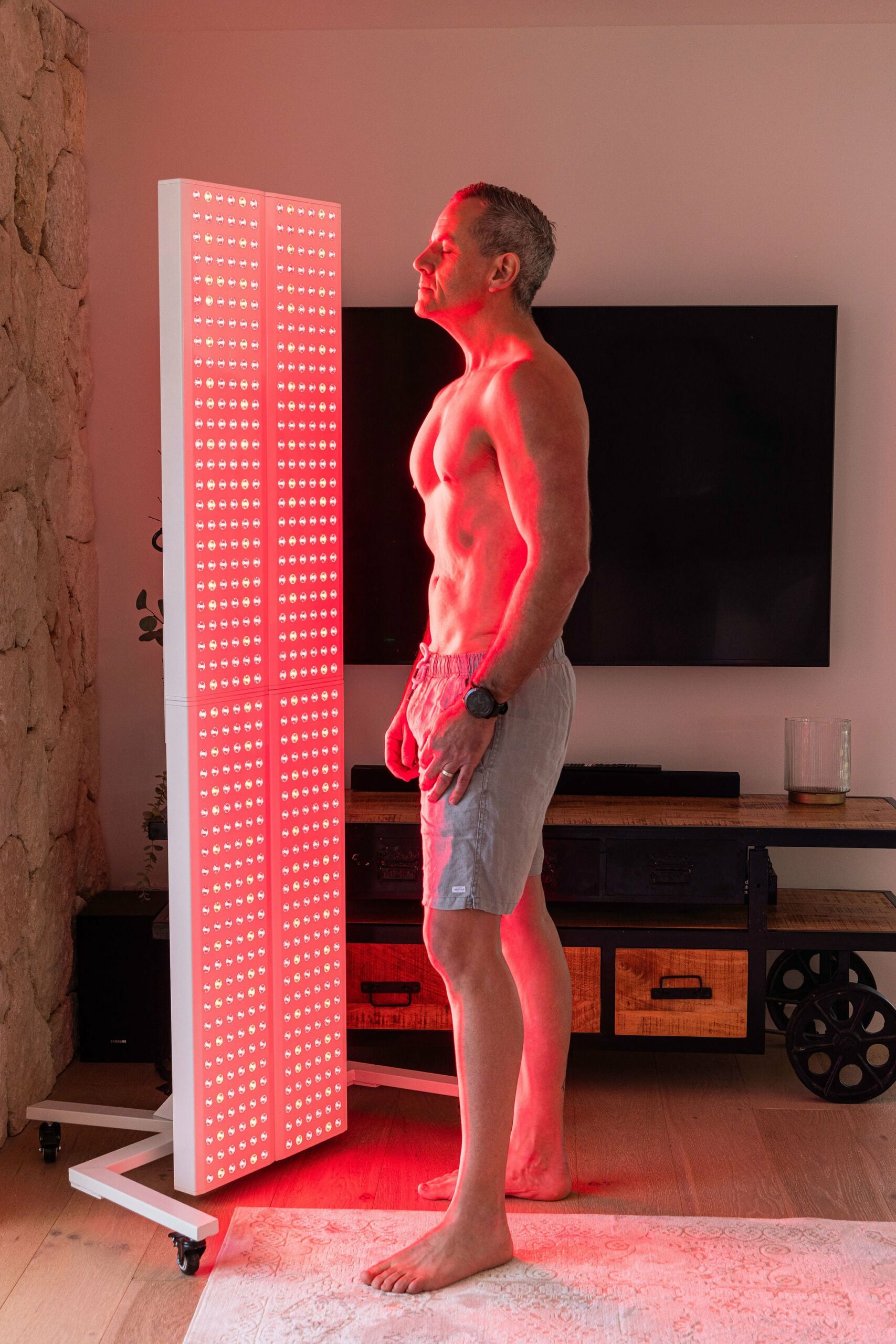
Red light is a type of visible light, Its wavelength falls between approximately 630 and 700 nanometers (nm) on the electromagnetic spectrum. Red light is often used in light therapy treatments for the skin, as it has been shown to have the most beneficial effects on skin cells and collagen production.
Near-infrared (NIR) light, on the other hand, has a longer wavelength than visible red light and falls between approximately 700 and 1200 nm on the electromagnetic spectrum. NIR light is not visible to the human eye, but it can penetrate deeper into the skin and other tissues than visible light, making it useful for a variety of therapeutic applications ranging from wound healing to inflammation reduction or improved circulation, among other benefits.
Different Red Light Therapy devices usually deliver slightly different wavelength ranges that research has shown to be the most effective for the concern they are being recommended for.
Red Light Therapy (RLT) strengthens the mitochondria, the cell’s powerhouse, where cell energy is created. Adenosine Triphosphate (ATP) is the critical energy-carrying molecule that is found in all living organisms. By optimizing the function of the mitochondria, more ATP is produced and with increased energy cells can function optimally.
This scientific breakthrough resulted in scientists discovering Red Light Therapy’s ability to stimulate and speed up tissue repair and growth. Red Light Therapy is now widely used for maintaining a healthy complexion, speeding up muscle recovery, reducing inflammation, improving sleep, treating neurological conditions, balancing hormones, treating pain, and even losing weight.
Research has also indicated that Red Light Therapy can help to restore cellular balance and alleviate the negative impact of blue light exposure. The prevalence of blue light in our society has become a growing concern as many individuals spend prolonged periods of time looking at screens on a daily basis.
Red Light Therapy (RLT) is also called:
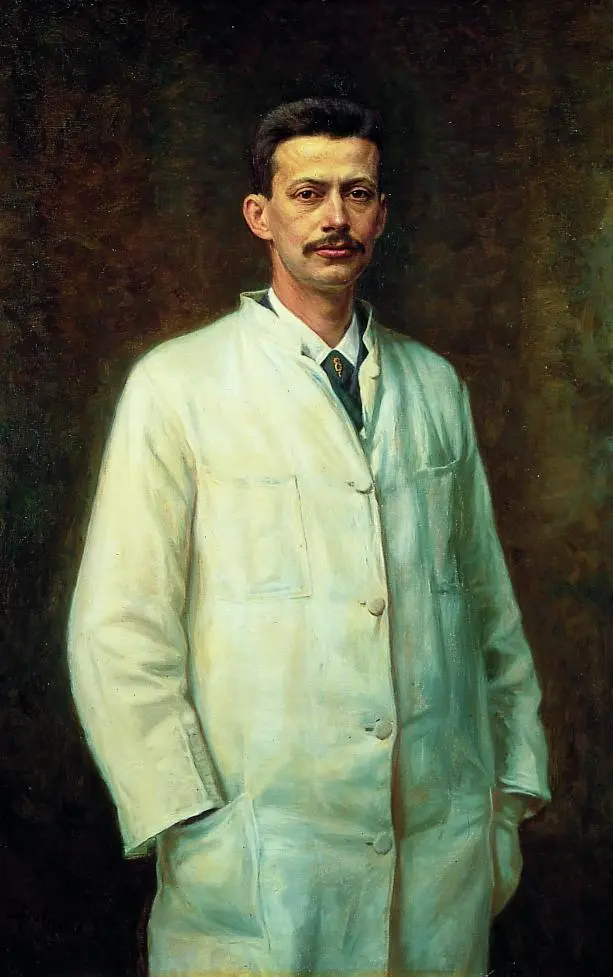
Low-Level Light Therapy (LLLT), Photobiomodulation (PBM), Cold Laser Therapy, Photonic Stimulation, Low-Power Laser Therapy (LPLT), Phototherapy
A Brief History of Red Light Therapy
The journey of Red Light Therapy (RLT) has been both fascinating and impactful, starting from its humble origins in the late 19th century. Dr. Niels Ryberg Finsen, the pioneer in light therapy, made a groundbreaking discovery in 1896 that light could be harnessed to treat Lupus Vulgaris, a form of tuberculosis affecting the skin. His work, which led to the tangible healing of skin lesions, was so revolutionary that he received the Nobel Prize in Physiology in 1903.
Fast forward to 1960, Theodore H. Maiman invented the first operational laser, fulfilling Albert Einstein's theories on the principles of lasers laid out in 1917. This invention opened new avenues for RLT, allowing more precise applications.

NASA took an interest in Red Light Therapy in 1987, conducting experiments to examine its effects on plant growth in space missions. These studies hinted at RLT's potential to benefit not just human health but also broader ecological systems.
In the same vein, Endre Mester's work in 1967 set the stage for modern RLT applications.
His experimentation with low-level laser therapy on skin cancer effects demonstrated the technique's efficacy and led to FDA approval for wound healing in 2002.
The advent of LED technology in the 1990s was a game-changer, offering an efficient and cost-effective alternative to traditional light bulbs. This technological leap made light therapy more accessible to the general public, including its use in sports medicine where physical therapists reported quicker recovery times for sports-related injuries.
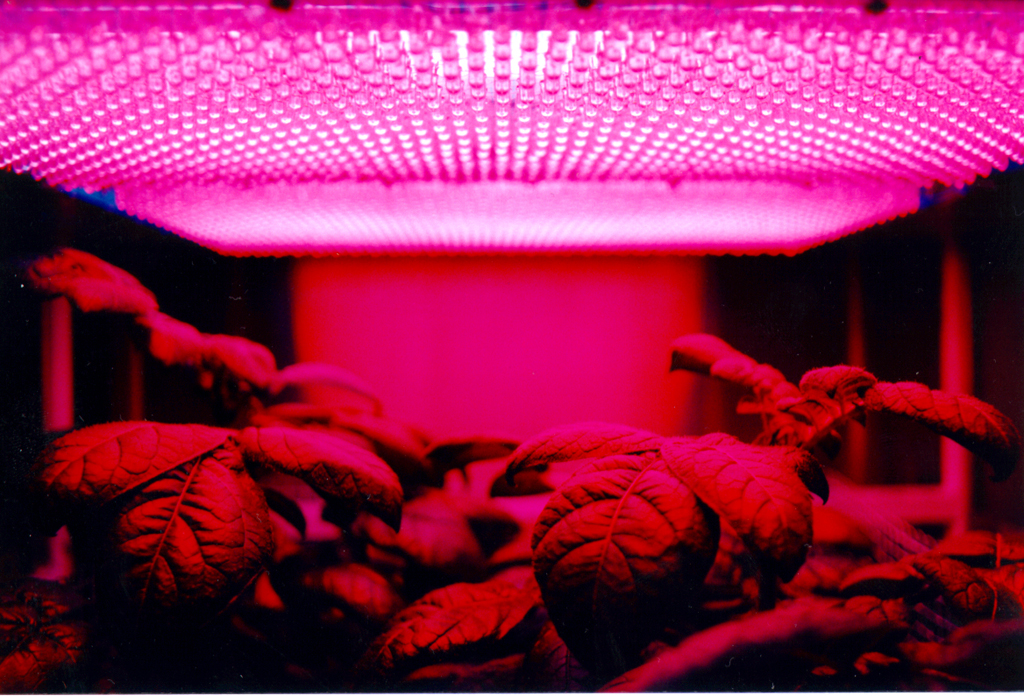
One of the most recent and exciting developments in RLT is its potential role in weight management. Studies indicate that Red Light Therapy can influence hormones like Leptin and Ghrelin, which play key roles in regulating appetite and metabolism. This makes RLT a promising avenue for non-invasive weight loss treatments.
As RLT continues to evolve, its applications keep expanding, crossing multiple disciplines from medicine to ecology. Researchers are continuously probing its potential, finding new ways to apply this age-old yet ever-advancing technology.
Our articles exclusively rely on primary sources of information, encompassing peer-reviewed medical journals and esteemed academic institutions.
- Mitochondria—Fundamental to Life and Health: https://www.ncbi.nlm.nih.gov/pmc/articles/PMC4684129/
- Effect of Blue Light on Acne Vulgaris: A Systematic Review: https://www.ncbi.nlm.nih.gov/pmc/articles/PMC8537635/
- Photodynamic And Photobiological Effects Of Light-Emitting Diode (LED) Therapy In Dermatological Disease: An Update: https://link.springer.com/article/10.1007/s10103-018-2584-8
- Clinical Efficacy of Self-applied Blue Light Therapy for Mild-to-Moderate Facial Acne: https://www.ncbi.nlm.nih.gov/pmc/articles/PMC2923954/
- A study to determine the efficacy of combination LED light therapy (633 nm and 830 nm) in facial skin rejuvenation https://www.researchgate.net/publication
- Phototherapy with Light Emitting Diodes: Treating a Broad Range of Medical and Aesthetic Conditions in Dermatology: https://www.ncbi.nlm.nih.gov/pmc/articles/PMC5843358/
- Low-Level Red And Infrared Light Increases Expression Of Collagen, Elastin, And Hyaluronic Acid In Skin: https://www.jaad.org/article/S0190-9622%2819%2933160-3/fulltext
- https://www.researchgate.net/publication/7357264_A_Study_To_Determine_The_Efficacy_Of_Combination_LED_Light_Therapy_633_Nm_And_830_Nm_In_Facial_Skin_Rejuvenation
- Dual Effect of Photobiomodulation on Melasma: Downregulation of Hyperpigmentation and Enhanced Solar Resistance—A Pilot Study: https://www.ncbi.nlm.nih.gov/pmc/articles/PMC5891084/
- Photobiomodulation: The Clinical Applications of Low-Level Light Therapy: https://pubmed.ncbi.nlm.nih.gov/33471046/
- Neonatal jaundice: phototherapy. BMJ Clinical Evidence, 2015, 0319. https://www.ncbi.nlm.nih.gov/pmc/articles/PMC4440981/
- Low-Intensity Light Therapy: Exploring the Role of Redox Mechanisms. Photomedicine and Laser Surgery, 26(4), 323–328. https://doi.org/10.1089/pho.2007.2184
- The Nobel Prize in Physiology or Medicine 1903. https://www.nobelprize.org/prizes/medicine/1903/summary/
- A NASA discovery has current applications in orthopaedics. Current Orthopaedic Practice, 26(1), 72–74. https://doi.org/10.1097/BCO.0000000000000196
- Why does skin wrinkle with age? What is the best way to slow or prevent this process? Scientific American. https://www.scientificamerican.com/article/why-does-skin-wrinkle-wit/
- A Controlled Trial to Determine the Efficacy of Red and Near-Infrared Light Treatment in Patient Satisfaction, Reduction of Fine Lines, Wrinkles, Skin Roughness, and Intradermal Collagen Density Increase. Photomedicine and Laser Surgery, 32(2), 93–100. https://doi.org/10.1089/pho.2013.3616
- LED lights: Are they a cure for your skin woes? https://www.health.harvard.edu/diseases-and-conditions/led-lights-are-they-a-cure-for-your-skin-woes
- Red/Near Infrared Light Stimulates Release of an Endothelium Dependent Vasodilator and Rescues Vascular Dysfunction in a Diabetes Model. Free Radical Biology and Medicine, 113, 157–164. https://doi.org/10.1016/j.freeradbiomed.2017.09.012
- Effect of 660 nm visible red light on cell proliferation and viability in diabetic models in vitro under stressed conditions. Lasers in Medical Science, 33(5), 1085–1093. https://doi.org/10.1007/s10103-017-2432-2
- Mechanisms and applications of the anti-inflammatory effects of photobiomodulation. AIMS Biophysics, 4(3), 337–361. https://doi.org/10.3934/biophy.2017.3.337
- Effects of low-power light therapy on wound healing: LASER x LED. Anais Brasileiros de Dermatologia, 89(4), 616–623. https://doi.org/10.1590/abd1806-4841.20142519
- Infrared and Skin: Friend or Foe. Journal of Photochemistry and Photobiology B: Biology, 155, 78–85. https://doi.org/10.1016/j.jphotobiol.2015.12.014
- Light-emitting diodes at 830 and 850 nm inhibit melanin synthesis in vitro. Acta Dermato-Venereologica, 92, 675–680. https://doi.org/10.2340/00015555-1319
- Light-based therapies in acne treatment. Indian Dermatology Online Journal, 6(3), 145–157. https://doi.org/10.4103/2229-5178.156379
- Light emitting diode-red light for reduction of post-surgical scarring: Results from a dose-ranging, split-face, randomized controlled trial. Journal of Biophotonics, 14(7), e202100073. https://doi.org/10.1002/jbio.202100073
- Effect of 660 nm Light-Emitting Diode on the Wound Healing in Fibroblast-Like Cell Lines. International Journal of Photoenergy, 2015, Article ID 916838. https://doi.org/10.1155/2015/916838
- Effect of Low-Level Laser Therapy on Proliferation and Collagen Synthesis of Human Fibroblasts in Vitro. Journal of Wound Management and Research, 14(1), 1-6. https://doi.org/10.22467/jwmr.2018.00283
- Low-level red and infrared light increases expression of collagen, elastin, and hyaluronic acid in skin. Journal of the American Academy of Dermatology, 81(4), AB434. https://doi.org/10.1016/j.jaad.2019.10.089
- Red light-promoted skin barrier recovery: Spatiotemporal evaluation by transepidermal potential. PLOS ONE, 14(7), e0219198. https://doi.org/10.1371/journal.pone.0219198
- Low-level red plus near infrared lights combination induces expressions of collagen and elastin in human skin in vitro. International Journal of Cosmetic Science, 43(3), 311-320. https://doi.org/10.1111/ics.12698
- Red Light Phototherapy Using Light-Emitting Diodes Inhibits Melanoma Proliferation and Alters Tumor Microenvironments. Frontiers in Oncology, 12. https://doi.org/10.3389/fonc.2022.928484
- The effects of low power laser light at 661 nm on wound healing in a scratch assay fibroblast model. Lasers in Medical Science, 38(1), 27. https://doi.org/10.1007/s10103-022-03670-5
- Clinical Effectiveness of Broad-band Infrared Light Therapy for Wrinkles and Skin Laxity of the Face. Journal of Clinical and Experimental Dermatological Research, 5(5). https://doi.org/10.4172/2155-9554.1000233
- Safety of light emitting diode-red light on human skin: two randomized controlled trials. Journal of Biophotonics, 13(3), e201960014. https://doi.org/10.1002/jbio.201960014
- Clinical effects of high-intensity laser therapy on patients with chronic refractory wounds: a randomised controlled trial. BMJ Open, 11, e045866. https://doi.org/10.1136/bmjopen-2020-045866
- Low-Level Laser (Light) Therapy (LLLT) in Skin: Stimulating, Healing, Restoring. Seminars in Cutaneous Medicine and Surgery, 32, 41-52. https://scmsjournal.com/articles/view_pdf/low-level-laser-light-therapy-lllt-in-skin-stimulating-healing-restoring
- Low Level Laser Therapy for the Treatment of Chronic Wound: Clinical Considerations. Biomedical and Pharmacology Journal, 8(2). https://dx.doi.org/10.13005/bpj/866
- The Need for Increased Attention to Low‐Level Laser Therapy as Treatment for Wounds and Ulcers. In Wound Healing – New insights into Ancient Challenges. https://doi.org/10.5772/64339
- Photodynamic and photobiological effects of light-emitting diode (LED) therapy in dermatological disease: an update. Lasers in Medical Science, 33, 1431–1439. https://doi.org/10.1007/s10103-018-2584-8
- Photobiomodulation in Dermatology: Harnessing Light from Visible to Near Infrared for Medical and Aesthetic Purposes. Medical Research Archives, 6(1). https://esmed.org/MRA/mra/article/view/1610/1689
- Photobiomodulation: The Clinical Applications of Low-Level Light Therapy. Aesthetic Surgery Journal, 41(6), 723–738. https://doi.org/10.1093/asj/sjab025
